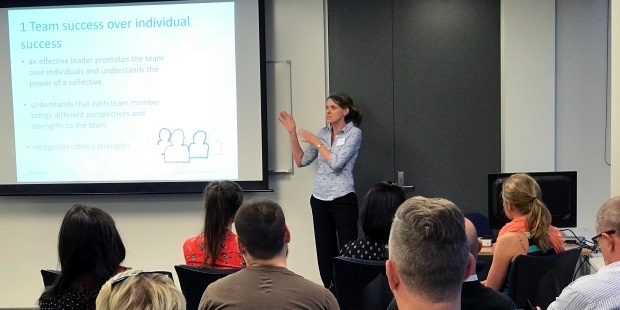Share this
Ten traits of effective IT leadership
by Kirstin Donaldson on 31 August 2018

Having worked as a project manager, general manager and Agile coach I have become interested in leadership and how great leaders help create teams who are engaged, motivated and deliver the results organisations need. On Wednesday evening, I delivered a presentation on '10 traits of effective IT leadership' to a group of Equinox IT clients and staff. In this post, I summarise some of my key points from this presentation.
It is important for us to pay attention to leadership. In IT and modern business our people are knowledge workers. Management theory began prior to the industrial revolution influenced by military, church and slave labour. During the industrial revolution the focus was on optimisation of work and management of resources; people managed using command and control approaches and the work was repeatable and predictable. However, leaders of knowledge workers today need to foster relationships and community, grow confidence and resilience, and generate engagement and fulfilment. The outcome is a productive, fulfilled and high performing team.
Discussing outward signs of effective leaders

I asked the audience to talk in groups and share some of the outward signs that show an organisation has effective leadership. Some of the points shared by the groups included:
- Leader implies there are followers
- The organisation has clarity
- Communication of a shared vision
- High retention rates
- Growth mindset
- 'Why' is clearly communicated
- Team members have a reason to get out of bed
- The right environment has been set.
I then went onto the traits I thought were important for leaders...
The ten traits of effective IT leadership
1. Team success over individual success
In IT we often see recruitment adverts for a 'rockstar developer'. I have worked with rockstar developers who were so good the rest of the team felt their contribution wasn't of value - the success of the team all rested on one person. In one example, we found that the team was stronger and delivered more value once the 'rockstar' left and a leadership style was adopted where all team members were encouraged to contribute to team success.
Effective leaders encourage a blend of skills and experience and set a culture where everyone has something to contribute.

2. Leads by example
"Do what I say not what I do" never works, people spot inconsistencies between "what we say" and "what we do", and what we do is what is followed. For example, I think it is important to respect people's time, show up to meetings on time and this sets a great example of the behaviour expected from others.
Effective leaders act consistently with organisational values exemplifying the behaviours expected of everyone else.
3. Empowering
Organisations have great processes to hire capable people into teams. As such, we shouldn't need to micromanage people. I once met Garry Ridge the CEO of WD40 and I've remembered his statement ever since "micromanagement doesn't scale". Likewise Mary Barra, Chairperson and CEO of General Motors, took their 10-page dress code and reduced it to two words "dress appropriately", empowering people to use their judgement to determine what is appropriate for different circumstances.
Effective leaders believe in the abilities of their team members and they empower them to deliver the required outcomes without micromanaging.
4. Integrity
Leaders need to show integrity, following through on what they agreed to do, dealing with poor performance, providing frequent and honest feedback, and taking responsibility for their decisions and actions. In a previous role, I once chose to apologise to my team for a change process that was done for good reasons but not communicated well. I showed vulnerability, admitting I was wrong and apologising for it. This helped strengthen the trust and bond in the team and enabled them to move on.
Effective leaders follow-through, show vulnerability, deal with issues and take responsibility.
5. Community builders
Building a sense of community, trust and support in a team is more than providing branded t-shirts. It is more about creating an environment where people care about each other and spend time together socially. Focus should be on providing social events that are inclusive - a "lads' poker night" event in isolation could mean some team members feel excluded.
Effective leaders create an environment where team members spend time together socially and care about each other.

6. Inspiring
Leaders who demonstrate passion, enthusiasm and positivity can inspire team members to work together towards a shared vision that the leader has helped create and communicate.
Effective leaders inspire others through passion, by generating enthusiasm, and with the communication of a shared vision.
7. Collaborative
Leaders should work with their teams, talking them up and putting them in the right positions to grow. Team involvement allows everyone to contribute ideas, share knowledge and communicate what is required. Leaders help others to become leaders themselves.
Effective leaders involve the team, seeking opinion, sharing knowledge, and giving and receiving feedback.
8. Strong communicator
It almost goes without saying that great leaders need to be strong communicators. When we look at well-known and successful leaders (e.g. Martin Luther King or Jacinda Ardern) communication is often a strength. Strong communication involves speaking plainly, being clear and concise. Because we encourage diversity in our teams, we should avoid certain metaphors (e.g. rugby themes), clichés and colloquialisms that may confuse some people, for example, those from different cultures. Strong communicators engage in conversations, listen and respond. They avoid monologues and one-way communication. Strong communicators often over communicate to ensure that the message is received.
Effective leaders are strong communicators who speak with clarity, engage in two-way conversation, listen, and over communicate when appropriate.
9. Ability to prioritise
Attempting to do multiple jobs at the same time often results in a poor outcome across the range of tasks. Leaders need to help their teams by identifying the highest value activities. Often leaders need to be informed using data and feedback to determine value and then persuade or influence other decision makers to agree the true priority.
Effective leaders are able to identify the work that is more valuable and prioritise.
10. Transparency
Transparency shows that leaders have nothing to hide and as quoted by the Dalai Lama "a lack of transparency results in distrust and a deep sense of insecurity". Leaders should encourage greater transparency. One way is by holding regular team or organisation wide 'town hall' meetings. I'm an advocate making work visible to everyone through Kanban or other visual work progress boards. Transparency also means being open about failures as well as successes.
Effective leaders are transparent, openly radiating information, progress, failures and achievements.
What leadership traits would you like to work on?

To wrap up the session I encouraged the audience to get back into groups to discuss any traits that were missed and what traits individuals wanted to work on to improve their own leadership. Although none of these traits are new ideas, I think it's worth leaders reflecting on their leadership style and the teams they would like to build and work with.
For yourself, you may also want to think about what traits you would like to work on to improve your leadership effectiveness.
Share this
- Agile Development (84)
- Software Development (64)
- Scrum (39)
- Business Analysis (28)
- Agile (27)
- Application Lifecycle Management (26)
- Capability Development (20)
- Requirements (20)
- Solution Architecture (19)
- Lean Software Development (17)
- Digital Disruption (16)
- IT Project (15)
- Project Management (15)
- Coaching (14)
- DevOps (14)
- Equinox IT News (12)
- IT Professional (11)
- Knowledge Sharing (10)
- Strategic Planning (10)
- Agile Transformation (9)
- Digital Transformation (9)
- IT Governance (9)
- International Leaders (9)
- People (9)
- IT Consulting (8)
- AI (7)
- Cloud (7)
- MIT Sloan CISR (7)
- ✨ (7)
- Change Management (6)
- Azure DevOps (5)
- Innovation (5)
- Working from Home (5)
- Business Architecture (4)
- Continuous Integration (4)
- Enterprise Analysis (4)
- FinOps (4)
- Client Briefing Events (3)
- Cloud Value Optimisation (3)
- GitHub (3)
- IT Services (3)
- Business Rules (2)
- Data Visualisation (2)
- Java Development (2)
- Security (2)
- System Performance (2)
- Automation (1)
- Communities of Practice (1)
- Kanban (1)
- Lean Startup (1)
- Microsoft Azure (1)
- Satir Change Model (1)
- Testing (1)
- November 2025 (1)
- August 2025 (3)
- July 2025 (3)
- March 2025 (1)
- December 2024 (1)
- August 2024 (1)
- February 2024 (3)
- January 2024 (1)
- September 2023 (2)
- July 2023 (3)
- August 2022 (4)
- July 2021 (1)
- March 2021 (1)
- February 2021 (1)
- November 2020 (2)
- July 2020 (1)
- June 2020 (2)
- May 2020 (2)
- March 2020 (3)
- August 2019 (1)
- July 2019 (2)
- June 2019 (1)
- April 2019 (2)
- October 2018 (1)
- August 2018 (1)
- July 2018 (1)
- April 2018 (2)
- January 2018 (1)
- September 2017 (1)
- July 2017 (1)
- February 2017 (1)
- January 2017 (1)
- October 2016 (2)
- September 2016 (1)
- August 2016 (4)
- July 2016 (3)
- June 2016 (3)
- May 2016 (4)
- April 2016 (5)
- March 2016 (1)
- February 2016 (1)
- January 2016 (1)
- December 2015 (5)
- November 2015 (11)
- October 2015 (3)
- September 2015 (1)
- August 2015 (1)
- July 2015 (7)
- June 2015 (7)
- April 2015 (1)
- March 2015 (2)
- February 2015 (2)
- December 2014 (3)
- September 2014 (2)
- July 2014 (1)
- June 2014 (2)
- May 2014 (8)
- April 2014 (1)
- March 2014 (2)
- February 2014 (2)
- November 2013 (1)
- October 2013 (2)
- September 2013 (2)
- August 2013 (2)
- May 2013 (1)
- April 2013 (3)
- March 2013 (2)
- February 2013 (1)
- January 2013 (1)
- November 2012 (1)
- October 2012 (1)
- September 2012 (1)
- July 2012 (2)
- June 2012 (1)
- May 2012 (1)
- November 2011 (2)
- August 2011 (2)
- July 2011 (3)
- June 2011 (4)
- April 2011 (2)
- February 2011 (1)
- January 2011 (2)
- December 2010 (1)
- November 2010 (1)
- October 2010 (1)
- February 2010 (1)
- July 2009 (1)
- October 2008 (1)